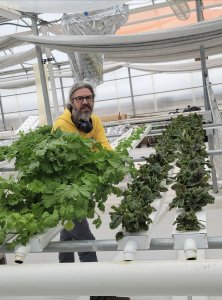
Hydroponic agriculture systems use water––not soil––to grow crops, and yet they use water with exceptional efficiency and can produce abundantly all year round. When coupled with fish farming, the result is a nearly closed-loop system––aquaponics––in which the plants filter the water for the fish, and the fish provide fertilizer for the plants.
Charlie Shultz is an Academic Director in the School of Trades, Technology, Sustainability and Professional Studies and Academic Director of the Controlled Environment Agriculture Program, including hydroponics and aquaponics, at Santa Fe Community College. The programs, which include food production and renewable energy, teach students to bring sustainable food and energy systems into communities, with the vision of building food, energy, water, and cultural sovereignty, and long-term alternatives to our current toxic infrastructures.
TIMELINE
3’01.9468 Controlled Environment Agriculture at Santa Fe Community College
3’45.1312 community asked for a food program
4’18.1887 what is aquaponics
4’28.8776 first LEED platinum building in New Mexico
4’47.2562 the waste from fish are nutrients for plants
5’18.5275 fish farming coupled with plant production
5’52.5057 reframing “waste” as a resource
6’50.4269 no need to buy fertilizer in aquaponics
7’35.2719 economics of growing food with fish water
8’01.1854 working with niche markets
8’30.1866 all the different crops they’re growing in the winter
9’26.5801 99.5% recycle rate of water in the aquaponic system, very water conservative use for food growing
10’22.2758 learned to do this work in the Virgin Islands, where there are also water shortages similar to desert climates
11’10.3821 greenhouse program at SFCC, hydroponics = growing plants without soil
12’35.4107 not certified organic but they think of it as “beyond organic” i.e. sustainable
13’57.4933 almost a closed-loop system, but they do buy fish food
15’46.7780 they are looking at community sovereignty–land, water, food, culture
17’08.2001 the evolution of the greenhouse
17’27.0923 traning the workforce of the future
19’26.7576 off-grid greenhouse
20’06.5546 a lot of different energy inputs
21’06.1649 cooling with evaporative coolers, which uses more water than watering the crops
22’21.2118 using water catchment
23’36.6234 dealing with bugs, mold
24’37.1960 using ladybugs to eat pest insects
25’41.4697 what students do with the knowledge they learn
25’56.5430 stealth STEM for young people who want to save the world and the food system
27’10.3034 once they get interested in food growing they start taking other science classes
27’47.4844 entrepreneurship is encouraged
28’50.7703 initiatives for underserved and remote communities
29’58.4787 dual credits pipeline from high school to community college
30’29.2916 cooperative extension service workshops across the state
31’15.8941 food miles–distance that food travels
32’32.7736 growing food during COVID
33’46.2570 what they do with the large amount of food they grow
34’41.5270 what the food tastes like
36’11.9091 growing aromatic/tasty herbs
36’52.7528 nutrient density
37’29.3517 prejudice against hydroponics
38’57.1537 both soil and hydroponic systems are teeming with microbes, many of the same microbes
39’52.1463 alternative energy programs at SFCC, they’re leading the nation in sustainability
40’17.9437 the food-energy-water nexus and distributed energy
42’55.1899 hydroponics is easily copied; aquaponics not so much
43’36.4627 cultivating fish is more complex and difficult than growing hydroponic crops
44’44.5405 the contaminants in the natural environment
45’53.9549 growing fish can be ecologically very efficient
46’52.3182 wild fish can be very contaminated
48’00.6878 labeling on seafood helps people to make good consumer choices
50’29.1168 greenhouses as source for winter food
51’53.4401 local, safe, and economic food production
52’11.8315 richard.shultz@sfcc.edu



Subscribe:
Apple Podcasts
Spotify